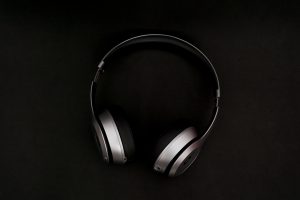Generally speaking, it’s not a good idea to clear your house in a home invasion. Best have a predetermined “safe room” where you and/or your family will gather while you call the cops and wait for the cavalry to arrive. And if an intruder enters this room, you will unload your self-defense arm into his/her center mass. In such a situation like this, ear protection would make sense, not only for you but the little ones (if you have children). Clearing a house—which, again, is nothing something that’s recommended—while wearing ear protection will mostly not. So we’re clear about ear protection. Unless we already have a safe room of some sort, we don’t recommend hearing protection period. The lovable Yankee Marshal–or hateable; the guy engenders strong emotions from viewers–thinks this is a bad idea too:
Now, with that caveat in mind (i.e., no safe room, no hearing protection), the first thing to consider is what type of ear protection is best for home defense if you have a safe room. The most immediate answer would be disposable foam earplugs or corded rubber earplugs. While not as effective as the over-ear types of hearing protection common to gun ranges, corded and foam earplugs are smaller and easier to store alongside the firearm you’re prepared to use in defense of your home.

Of the two, the corded rubber earplugs are probably best for a home defense scenario because they do not take time to expand once in your ears. Once they’re in, they’re protecting your hearing. Similarly, they take less time to put on because you don’t have to flatten them before inserting them in your ears. Inversely, foam earplugs require a little fussing around, which you may not have the time for.
Of course, consider if your corded earplugs fit your ears well enough to be beneficial to you. One of the benefits of foam earplugs is they are fully molded to your ear, where corded earplugs are not. Test your corded earplugs at the range and make sure they work for you before you stash them with your home defense weapon. Once you know they work, you can count on your hearing being protected in the event of a home invasion.
In a completely ideal situation, you may have a larger area to store your home defense firearm that can also accommodate a set of over-ear hearing protection. These headphones can collapse into themselves to reduce their overall size by around a third of the size when being worn, but they are still very large. You know how much space your ear protection takes up in your range kit – if you have that much space where you’re keeping your home defense weapon, then you may want to buy a second set of your favorite over-ear headphones and keep them on hand.
If you happen to have that luxury, which most don’t, having the over-ear protection can be ideal because it takes the least time to put on and will work for any member of your household, in addition to being the most effective. Over-ear headphones offer the most protection and noise cancellation of all hearing protection and can be put on in one motion.
One of the drawbacks is that while you’re not actively firing your gun, you won’t be able to hear as well. There are types of over-ear hearing protection geared toward hunting that allow you to hear the world around you when not in the presence of gunfire, but they are much larger than their basic brethren and more than a little impractical to store wherever you’re storing your home defense firearm.
I’ve mentioned it a few times already, but the second thing to consider about ear protection for home defense is where and how you’re storing your ear protection. Always store your ear protection right next to the firearm you intend to use in the event of a home invasion. That way you’re not scrambling for ear protection in a second location when time is of the essence. However storing your ear protection may look, be it a case for corded earplugs, a baggie or box of foam earplugs, or a stand-alone pair of over-ear headphones, make sure your hearing protection of choice can be easily accessed, even in the dark. Make sure boxes or baggies are easy to open and that you can remove your ear protection from its storage space quickly and without obstruction.

If ear protection is not something you’ve really considered as part of your home defense plan until now, it’s worth considering the sequence of events that may occur when you are preparing to discharge your weapon in a home invasion scenario. It may seem counterintuitive, but always have your weapon hot and within reach before taking the time to put on ear protection.
In an absolute worst-case scenario, you may need to fire your weapon before you have time to put on ear protection. If that happens, well, you won’t be worried about hearing loss since you’re in a life or death situation If that hearing loss is major and permanent, however, you just might regret having taken the extra few seconds to protect your hearing rather than being prepared to protect your life.
That sounds dramatic, but there is a point there. While no one wants to experience the partial hearing loss that comes with firing a gun without ear protection, it’s something you can and will recover from. So when using ear protection in a home defense situation, always consider your priorities and how much time you believe you have. And that’s where the benefits of corded and over-ear hearing protection really become apparent – the time it takes before either of these devices become useful. In a home invasion, every second counts.
A word of caution about having a loaded firearm out while your hands are occupied putting on ear protection, though: make sure the gun is somewhere safe and stable within arms’ reach. If you’re reading this article, we can all bet you know your way around guns and know gun safety practices fairly well. It’s still absolutely worth mentioning again though, so it’s something you consider when building your home defense plan.
That plan is something that has also come up a few times in this article. And that’s for good reason. Even if you had a plan (i.e., having a “safe room” for everyone to gather and how to get there quickly) and you’ve rehearsed it in your mind (or, at worst case scenario, actually had to act on it), rehearse it a few more times now that you’re planning on using ear protection and consider where you’re setting your firearm while you’re putting on your hearing protection.
You’re on the right track thinking about how to protect your and your loved ones’ hearing while protecting your home. Take some time and consider what works best for you and what you can do quickly in the event of a home invasion, which we all hope never happens. Good luck!



